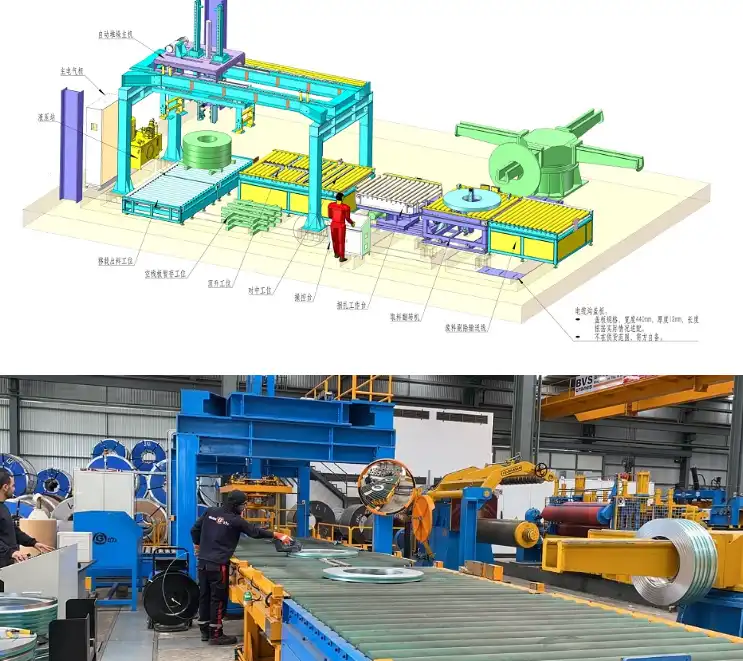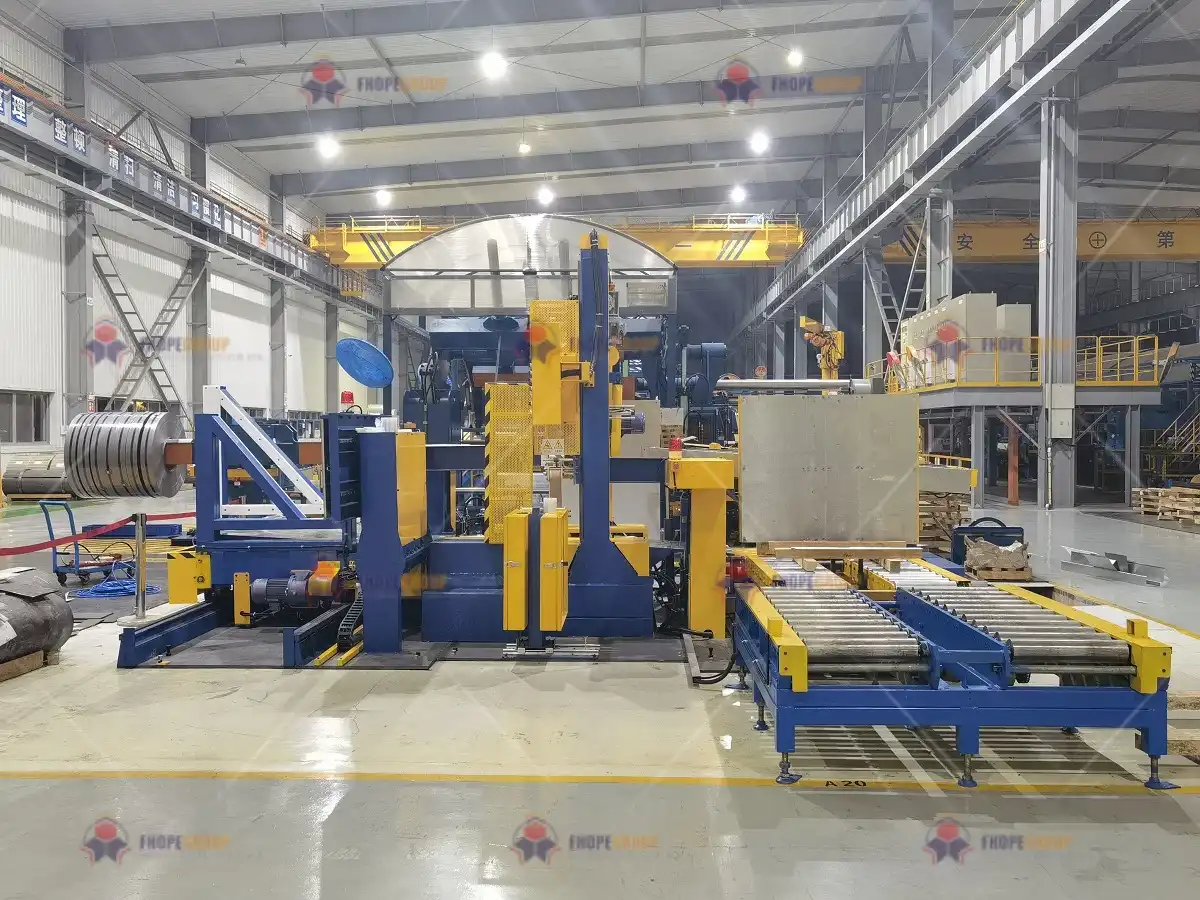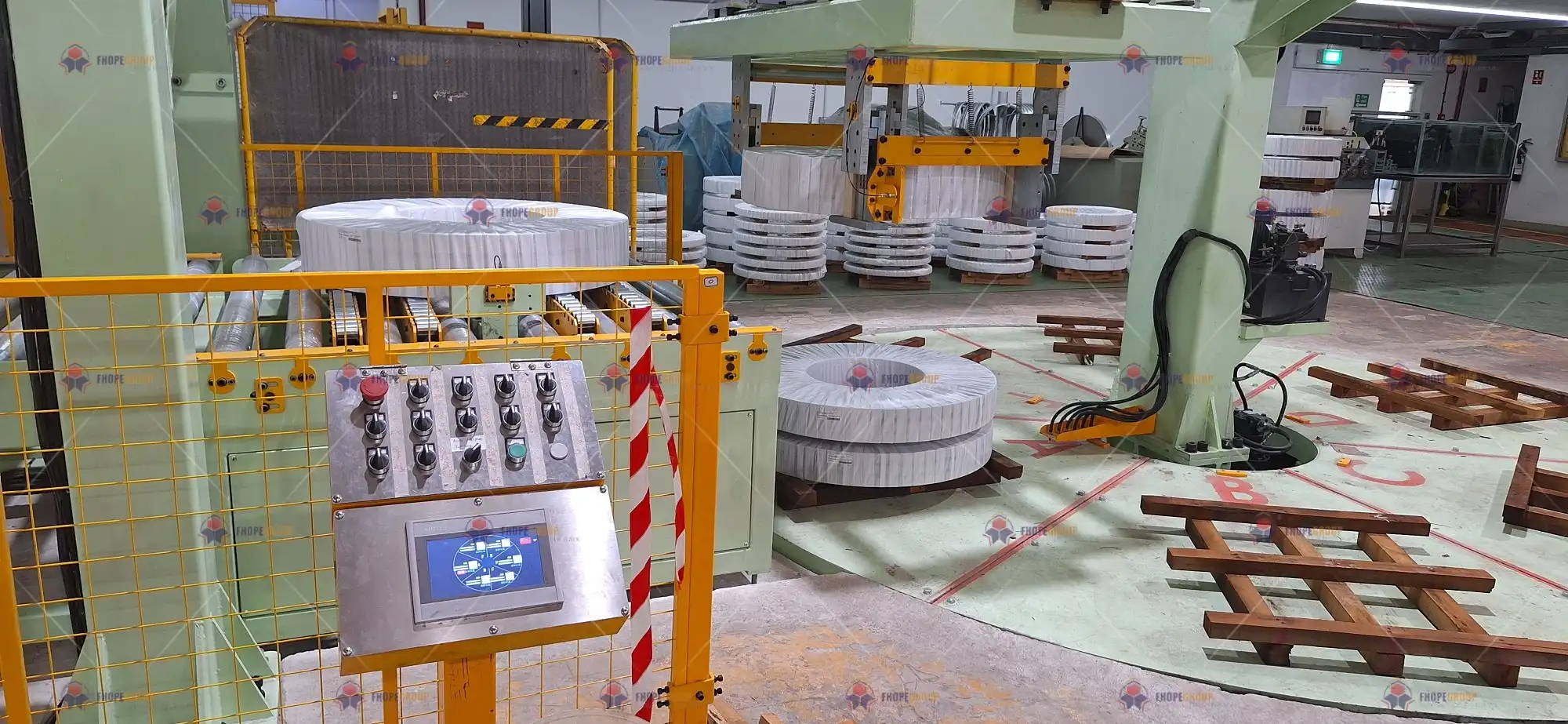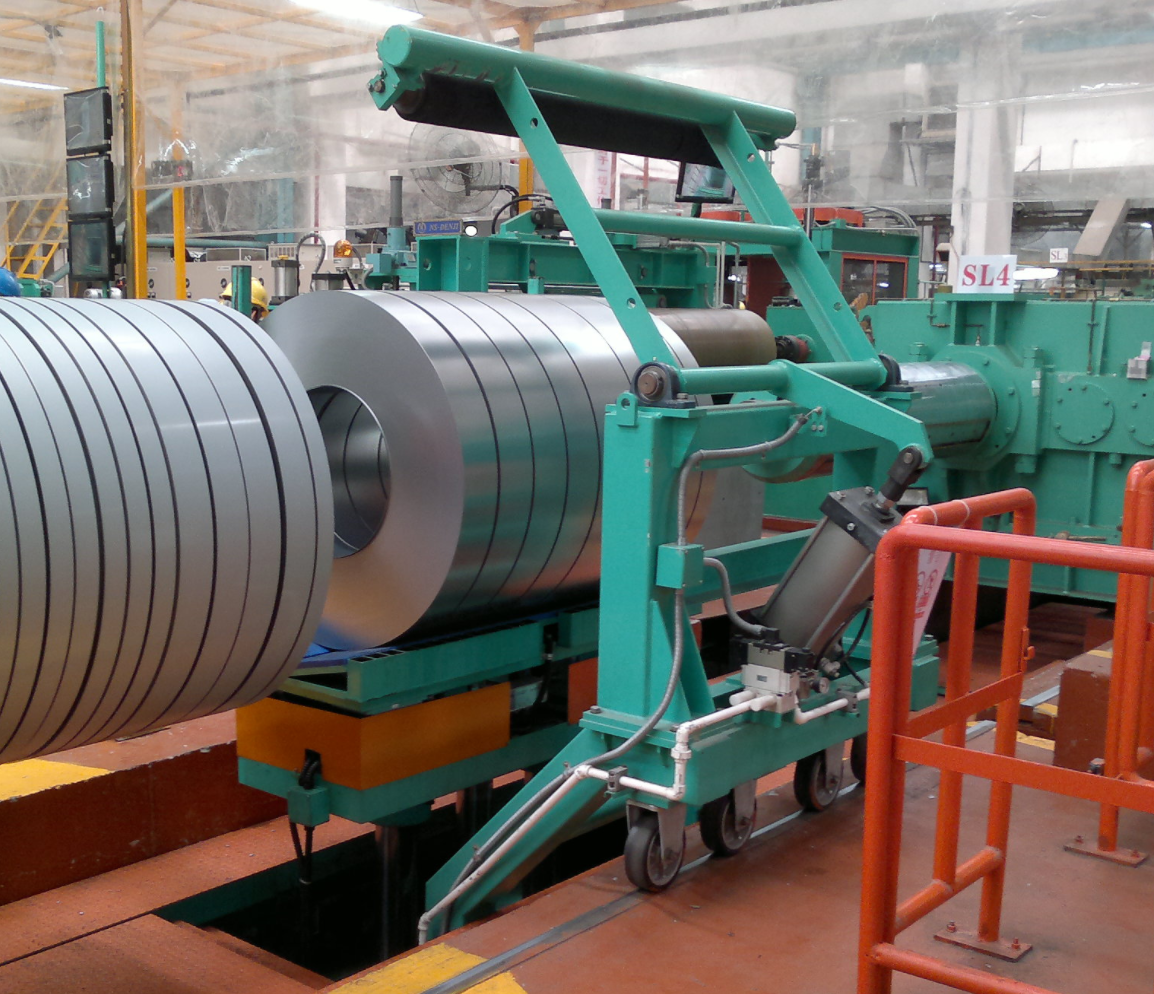Running a steel mill is a tough business. I know because I've spent my entire career in this industry. You are constantly balancing on a razor's edge. You have to manage fluctuating energy prices, deal with aging machinery, and meet ever-stricter environmental rules. On top of it all, the market demand for steel can change in a heartbeat. It feels like you are fighting battles on multiple fronts every single day. The pressure to reduce costs and increase output never stops. And often, the final step in your process—the coil packing line—is an overlooked source of major bottlenecks and hidden costs.
Smart coil packing solutions boost throughput by automating repetitive tasks, integrating seamlessly with production scheduling, minimizing downtime through predictive maintenance, and ensuring consistent, high-quality wrapping. This strategic upgrade directly attacks bottlenecks at the end of your line. It increases the speed at which your finished steel coils are protected, labeled, and made ready for shipment, turning a cost center into a powerful asset for your entire operation.

I have walked through countless mills in my time, first as an engineer and later as a factory owner myself. I’ve seen the same problems again and again. I’ve also seen how the right technology can completely transform an operation. The journey from being an employee to running my own successful packing machine factory taught me one thing: solving the right problem is everything. Your packing line might seem like a small part of your massive operation, but optimizing it can have a ripple effect that improves your entire business. Let’s break down how this works and look at the real challenges you face every day.
How Can Automated Packing Lines Tackle Aging Equipment and Rising Labor Costs?
You have a team of experienced workers, but many are nearing retirement. The equipment they run has been on the floor for over 15 years, and the breakdowns are becoming more frequent and more costly. Finding new, skilled people to run these old machines is getting harder and more expensive every year. This is a common story I hear from mill owners. It’s a challenge that keeps them up at night. Each time a machine fails, your entire production line can grind to a halt. The costs add up quickly: lost production, overtime for maintenance crews, and the risk of not meeting customer deadlines. Relying on manual packing for such a critical step is slow, inconsistent, and frankly, unsafe.
Automated packing lines directly solve these problems. They replace unreliable, aging machinery with new, highly reliable systems designed for 24/7 operation. This reduces your dependence on a shrinking pool of skilled manual labor. By automating key tasks, these lines provide consistent performance, lower the risk of failure, and allow you to reassign your valuable team members to more complex, higher-value roles within the plant.

Dive Deeper: Moving from Reactive Fixes to Proactive Solutions
For years, many mills have operated on a "if it ain't broke, don't fix it" philosophy. But with equipment that's 15 or 20 years old, "broke" is becoming a daily occurrence. The true cost of this old machinery isn't just the price of a replacement part. It's the hidden expenses that bleed your budget dry.
The Real Cost of "Good Enough" Equipment
The old packing line might seem "good enough," but its inefficiency is a constant drag on your profitability. Think about the unplanned downtime. When the wrapper or strapper goes down, coils start piling up. This can force you to slow down or stop your slitting and rolling lines, which is a massive financial hit. Then there is the maintenance overtime needed to get the line running again. Furthermore, old machines lack the precision of modern systems. They might use more stretch film than necessary or apply straps inconsistently. This leads to wasted materials and, even worse, product damage during shipping. I once worked with a client whose damage claims from transport were costing them tens of thousands of dollars a year. The problem was traced back to inconsistent wrapping from an old, poorly maintained machine.
A New Strategy for Your Workforce
Automation is not about getting rid of jobs. It is about changing the nature of work for the better. Your experienced operators know your products and processes inside and out. They are too valuable for repetitive, physically demanding tasks. An automated line frees them to become line supervisors, quality control technicians, or skilled maintenance planners. I remember one plant manager who was very concerned about his older workers adapting to a new automated system. We focused on designing a system with a very simple, intuitive touch-screen interface (HMI). Within a week, those same veteran workers were the ones training the younger employees. They felt empowered, not replaced.
Here is a simple breakdown of the operational shift:
| Metric | Manual / Old Line | Automated Line |
|---|---|---|
| Throughput | Inconsistent, operator-dependent | High, consistent, predictable |
| Labor Required | High (2-4 operators/shift) | Low (1 supervisor/shift) |
| Wrap Quality | Variable, potential for damage | Uniform, high-protection standard |
| Downtime | Frequent, unplanned | Minimal, planned maintenance |
| Safety Incidents | Higher risk of strains, cuts | Drastically reduced risk |
This transition is a strategic move. It solves your immediate equipment reliability and labor challenges. It also builds a more skilled, resilient, and safer workforce for the future.
What's the Real ROI of Integrating a Smart Coil Packing System?
As a business owner, you scrutinize every major purchase. You have to. A new packing line is a significant capital investment, and you need to be certain it will pay for itself and deliver a strong return. It's easy to see the price tag on the quote. It's much harder to quantify the full, long-term financial benefits. But sticking with an old, inefficient system isn't free. It costs you money every single day in wasted materials, excess labor, and lost productivity. These hidden costs are a quiet drain on your profits, making it harder to reach your goal of reducing overall operating costs.
The real ROI of a smart coil packing system comes from a powerful combination of direct cost savings and new revenue opportunities. It dramatically cuts your spending on labor and packaging materials. It reduces product damage and associated claims. It increases your throughput, which can allow you to sell more product. And it even lowers your energy bills. When you look at the complete picture, the financial case becomes very clear.

Dive Deeper: A Financial Analysis for the Practical Owner
Every investment decision comes down to the numbers. A forward-thinking leader like yourself needs more than just promises; you need a solid business case. Let's break down the return on investment (ROI) for a modern coil packing line, focusing on the metrics that matter to a steel mill owner. This is the same kind of analysis I used to do when I had to justify investments for my own factory.
Reducing Your Operational Expenses (OPEX)
This is where the most immediate savings are found. An automated line directly attacks your largest variable costs.
- Labor Savings: A fully automatic line can often be managed by a single supervisor, instead of the 2, 3, or even 4 operators needed for a manual or semi-automatic process. This allows you to reallocate labor to other critical areas of the mill without increasing headcount.
- Material Savings: Modern stretch wrapping machines have advanced pre-stretch heads. These can stretch a roll of film by up to 300%. This means you use far less film to achieve the same or better load containment. For a high-volume mill, this can translate into savings of tens of thousands of dollars per year on film alone.
- Energy Savings: New equipment uses high-efficiency motors and smart controls. The line only runs at full power when it is actively packing a coil. This eliminates wasteful idling and directly contributes to your goal of reducing unit energy consumption.
Beyond the Obvious Savings: Unlocking Hidden Value
The ROI isn't just about cutting costs. It's also about what a new system enables you to do.
- Drastically Reduced Damage Claims: Inconsistent manual wrapping is a primary cause of coil damage during handling and shipping. A modern system provides a uniform, secure, and highly protective package every time. This protects the coil from moisture, dirt, and physical impacts. Fewer damage claims means less paperwork, no replacement costs, and happier customers.
- Increased Mill Throughput: Your packing line is often the final bottleneck. If it can't keep up with your slitters or rolling mills, you are forced to slow down your entire production process. A faster, more efficient packing line can unlock that hidden capacity. I worked with a mill in the Midwest that was able to increase the output of their slitting line by 15% simply because their new packing line could handle the volume. They didn't have to invest millions in a new slitter; they just had to unclog the drain at the end of the pipe.
Here is a simplified way to think about the payback calculation:
| ROI Component | Description | Impact on Your Goals |
|---|---|---|
| Direct Savings | Reduced labor, film, and energy costs. | Directly supports 8% cost reduction goal. |
| Indirect Savings | Fewer damage claims, less maintenance. | Improves profit margin and reliability. |
| Revenue Gain | Ability to run production lines faster. | Helps achieve 95% capacity utilization. |
| Initial Investment | The upfront cost of the equipment. | A capital expense with a clear payback. |
By analyzing these factors, we can often demonstrate a payback period of less than two years. It's a strategic investment that pays dividends long after the initial cost is recovered.
How Do Modern Packing Solutions Enhance Worker Safety and Meet Compliance Standards?
The packing and shipping area of a steel mill can be a hazardous environment. You are dealing with coils that weigh several tons, sharp steel edges from strapping, and physically demanding, repetitive tasks. As a leader, the safety of your people is your number one priority. A single accident is one too many. It can have a devastating impact on an employee and their family. It also leads to production downtime, investigations, and potential fines from regulatory bodies. On top of this, you face growing pressure to meet strict environmental standards for energy use and waste.
Modern packing solutions are designed with safety as a core principle, not an afterthought. They engineer the hazards out of the process by automating the most dangerous tasks. This removes your workers from harm's way. These systems also incorporate energy-efficient technologies and precise material usage that help you meet your environmental compliance goals. It's about creating a workspace that is not only more productive but also fundamentally safer and more sustainable.

Dive Deeper: Building a Culture of Safety and Responsibility
A safe plant is a productive plant. When your employees feel secure, they can focus on quality and efficiency. Investing in safer equipment sends a powerful message to your team: we value you. This is something I learned early in my career. The best-run factories I ever saw were always the safest ones.
Engineering Safety into the Process
Instead of relying solely on training and personal protective equipment (PPE), modern design automates the risks away. It builds a protective bubble around the entire process.
- Automated Handling: Tasks like lifting coils, upending them from eye-to-sky, and moving them between stations are some of the most dangerous. Using automated coil cars, turnstiles, and walking beams eliminates the need for forklifts to maneuver in congested areas and removes the risk of crush injuries.
- Hands-Free Strapping and Wrapping: Manually applying steel straps is a common source of deep cuts. Manually wrapping a coil forces an operator to walk backward in a circle, creating a trip hazard. Automated strapping heads and wrapping shuttles perform these tasks flawlessly without any human interaction, keeping hands and bodies at a safe distance.
- Comprehensive Guarding: All modern lines come with robust physical fencing to prevent accidental entry into the machine's operational space. This is backed up by light curtains and safety scanners at entry and exit points. If a person or object breaks the light beam, the entire line stops instantly.
I'll never forget a visit to an old mill where I saw a worker straining to wrap a massive coil by hand. He was walking backward, pulling a heavy roll of film, with forklifts moving around him. It was a recipe for disaster. When we installed their new automated line, the relief on the faces of the workers was incredible. The operator now manages the entire process from a safe, ergonomic control station.
Meeting Environmental and Quality Mandates
Your responsibility extends beyond the factory walls. Modern systems help you become a better corporate citizen.
- Energy Efficiency: As mentioned before, the use of high-efficiency motors and variable frequency drives (VFDs) means the line only consumes the energy it needs for the task at hand. This directly supports your goal of lowering unit energy consumption by 10%.
- Waste Reduction: Precision matters. By using the exact amount of stretch film and strapping required, you reduce your consumption of plastics and steel. This lowers your costs and minimizes your environmental footprint.
- Quality and Traceability: To meet quality standards like ISO 9001, you need records. Automated lines can integrate scales, printers, and label applicators. Each coil gets a unique ID with its weight, dimensions, and packing date. This data is logged automatically, providing perfect traceability for compliance and customer requirements.
Here’s a quick checklist of how modern features address these concerns:
| Safety/Compliance Feature | What It Does | Benefit |
|---|---|---|
| Full Perimeter Fencing | Creates a physical barrier around moving parts. | Prevents accidental contact and injuries. |
| Light Curtains | Creates an invisible safety barrier. | Instantly stops the machine if crossed. |
| Automated Coil Cars | Transports heavy coils automatically. | Reduces forklift traffic and manual handling. |
| VFD Motors | Adjusts motor speed to the load. | Reduces energy consumption and waste. |
| Automatic Labeling | Prints and applies ID/shipping labels. | Ensures 100% traceability for quality control. |
Why Should Your Packing Line Be a Data Hub for Your Entire Mill?
You are making a significant push towards digital transformation in your mill. You are implementing MES platforms, installing IoT sensors, and using data to make smarter decisions. But if your packing line isn't connected to this digital ecosystem, you have a massive blind spot. You can't truly manage your production flow if you don't have real-time information from the very last step in the process. Without this data, your production schedules are based on estimates, not reality. You don't know the precise cycle times, the root causes of delays, or the real-time status of your finished goods inventory. This makes achieving a 95% capacity utilization rate an uphill battle fought with incomplete information.
A smart packing line is not just a piece of machinery; it is an intelligent data node. It is designed to communicate. It connects seamlessly with your plant's MES and ERP systems, providing the critical, final piece of the puzzle for total production visibility. It transforms your packing area from a "black box" into a transparent, data-rich asset that helps you optimize your entire operation, from the furnace to the shipping dock.

Dive Deeper: Turning Raw Data into Actionable Intelligence
In my own journey building a packing machine factory, the biggest leap forward came when we stopped thinking about our machines as just mechanical devices. We started thinking of them as data collection tools. For a steel mill owner focused on digital transformation, this is the most powerful aspect of a modern system.
From Dumb Iron to Smart Asset
An old packing line is just "dumb iron." It does a job, but it doesn't tell you anything. A smart line is packed with sensors and intelligence.
- The Technology: The heart of the system is the PLC (Programmable Logic Controller). It acts as the brain, receiving information from a network of sensors: photoelectric eyes that detect a coil's presence, proximity switches that confirm a machine's position, scales that record the exact weight, and barcode scanners that read the coil's unique ID.
- The Integration: This data doesn't stay locked in the machine. It is communicated over standard industrial protocols (like Ethernet/IP or Profinet) to your plant-level systems. I have seen implementations where the MES sends the next coil's ID and dimensions directly to the packing line. The line then automatically adjusts its strapping positions and wrapping parameters without any operator input. This eliminates human error and minimizes changeover time.
Data That Drives Real-World Decisions
Once you have this data flowing, you can use it to achieve your highest-level goals.
- True Predictive Maintenance: This is key to reaching your 95% uptime goal. The system tracks everything: motor run hours, the number of cycles on the strapping head, the number of rotations of the wrapper. You can set thresholds to automatically generate a maintenance work order in your CMMS before a component fails. This shifts your maintenance from a reactive, fire-fighting mode to a proactive, planned activity.
- Pinpoint Performance Analysis: With hard data, you can finally answer critical questions. Why was throughput on the night shift 10% lower than the day shift? Which coil sizes are taking the longest to process? Is a specific component causing frequent micro-stoppages? This data, visualized on dashboards, allows your engineers and managers to identify bottlenecks and implement targeted improvements.
- Streamlined Logistics: Your shipping department no longer has to guess what's ready to ship. They can see in real-time the moment a coil is fully packed, weighed, and labeled. This allows them to schedule trucks with much greater precision, reducing yard congestion and getting your product to your customers faster.
This data stream is the foundation for continuous improvement.
| Data Point from Smart Line | How It's Used | Impact on Your Goal |
|---|---|---|
| Coil ID and Weight | Automatic generation of shipping documents. | Improves accuracy, saves admin time. |
| Cycle Time per Coil | OEE and throughput calculation. | Measures progress towards 95% utilization. |
| Material Usage (Film/Straps) | Cost analysis and inventory management. | Helps control costs for 8% reduction target. |
| Machine Fault Codes | Root cause analysis for downtime. | Identifies issues to improve reliability. |
| Component Cycle Counts | Triggers for predictive maintenance. | Maximizes uptime and equipment life. |
Your packing line sits at the crossroads of production and logistics. By turning it into a data hub, you give yourself the visibility and control needed to run a truly optimized, data-driven steel mill.
Conclusion
Investing in a smart packing line is not just an equipment upgrade. It’s a strategic move to boost throughput, cut costs, and future-proof your entire steel mill operation.




